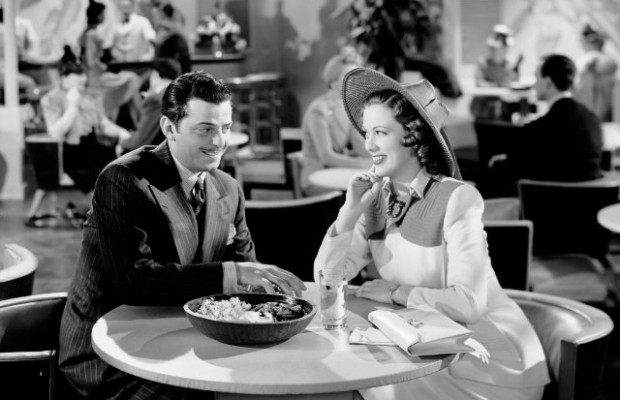Lady Be Good (1941)
By on September 24, 2013
 |
Lady Be Good (1941)
 Run time: Run time: 112 min  Rating: Rating: 6.4  Genres: Genres: Comedy | Musical  Director: Director: Norman Z. McLeod, Busby Berkeley  Writers: Writers: Jack McGowan, Jack McGowan  Stars: Stars: Eleanor Powell, Ann Sothern, Robert Young |
Storyline
Songwriters Dixie Donegan and Eddie Crane are still in love after their divorce. Dixie’s friend Marilyn Marsh tries to convince them to marry again, but this isn’t that easy. Written by Stephan Eichenberg <eichenbe@fak-cbg.tu-muenchen.de> |
Details:
Release Date: 10 November 1941 (UK) |
Box Office
Budget: $863,460 (estimated) |
|


Everyone in this movie is terrific, and the story is one of the better ones among musicals of the period. The songs and dances are great, too, with two of the high points being beautiful Ann Sothern's "The Last Time I Saw Paris" and Eleanor Powell's dancing finale. But most amazing of all is Powell's duet with her dog. This number should be rated along with Fred Astaire's dance on the ceiling in "Royal Wedding" and Donald O'Connor's "Make 'Em Laugh" as one of the best of all time. If you're looking for social commentary, turn on NPR. If you want something deep, find a stable and pick up a shovel. This movie was meant to be fun and entertaining, and it succeeds perfectly on both counts.
The only resemblance between this film and the Broadway musical and silent film of Lady Be Good from 1928 is purely coincidental. All that MGM took for this film was the title and two songs from the original Broadway score.
That being said this version of Lady Be Good about a pair of husband and wife songwriters is good entertainment. Robert Young and Ann Sothern are the married pair and it's the same old story of two who can't live and can't live without each other. In fact the story is told in flashback by Sothern on the witness stand to Judge Lionel Barrymore in her divorce hearing.
The rest of the score is written by those MGM contract writers Arthur Freed and Nacio Herb Brown. None of it is particularly memorable. However an additional song which brought this film its only Oscar caused some considerable controversy.
The year before Oscar Hammerstein, II saw newsreels of the Nazis marching into Paris and the sad faces of the French people who now had to endure the unendurable. He spent some considerable time in Paris and loved the city. So moved was he that he dashed off a song lyric and immediately called Jerome Kern to put some music to it. The result was the incredibly popular The Last Time I Saw Paris.
So popular was it that MGM I'm sure paid a pretty penny for the rights and to interpolate into Lady Be Good. Tony Martin and Lanny Ross and Kate Smith and the great concert singer John Charles Thomas had made some good selling records of The Last Time I Saw Paris. Ann Sothern sang it beautifully in the film, the last chorus with her voice over newsreels of the occupation.
The popularity of the song and the entrance of the USA into World War II no doubt influenced the vote of the Academy. Plus the fact that interpolated songs like this were not specifically banned. It was sheer coincidence that the six of the first seven winners were original songs written specifically for the film they were in.
The Academy rules were tightened up and now songs had to be written specifically for the film. So Sweet Leilani and The Last Time I Saw Paris remain the only two songs not written for the films they were in. By the way Jerome Kern fought for the rule change himself, saying he voted for Harold Arlen-Johnny Mercer's Blues in the Night as the best song for 1941.
The other musical highlight is Eleanor Powell dancing to Fascinating Rhythm. On stage it was Fred and sister Adele Astaire who did it originally, but there ain't nothing wrong about the way Eleanor Powell cuts that carpet. Busby Berkeley directed the sequence and it's filled with his original touches.
One day maybe I'll see a theatrical production of George&Ira Gershwin's Lady Be Good. Till then this will do nicely.
The fabulous tap dance and flash styling of the Berry Brothers is complimented by Eleanor Powell’s beautiful tap and acrobatics. The Berry Brothers have never gotten the credit they deserved. Their artistry is something that has not been duplicated all these years later. From Tap Dance, Spins, Cane work to handsprings into splits, these men did it all! In this movie Eleanor Powell demonstrates she was one of the few women who genuinely deserved the solo spot in tap dancing. Musicals like this are sorely missed in today’s entertainment. In the days this movie was produced, special effects, computer graphics couldn’t take the place of talent. Truly a treasure of tap dance history. A must see for any tap enthusiast!!!
I have to give this film an eight simply because The Berry Brothers appeared in it (I love them – what incredible talent) which was pretty unusual for a 1940's "white" film, AND also because of the incredible, breathtaking, amazingly choreographed and executed dance sequences at the end of the film.
The film also has sublime bits throughout, such as the tap dances that includes Eleanor Powell tap-dancing with "Blackie," a captivating black and white terrier-mix dog, "Miss Deadpan" (Virginia O'Brien) who delivers her own style of comedic twists to the songs she sings in the film and, of course, Robert Young and Ann Sothern contribute their own charm to enrich the film.
TIVO the film and fast-forward to the song and dance numbers – they are worth the wait!